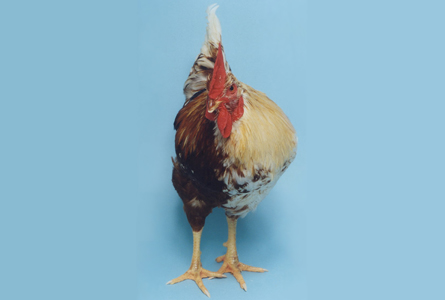Half rooster, half hen
Study of special chickens suggests new thinking on hormones and gender.
A new study on chickens is making news, and it has nothing to do with crossing the road. Or with whether or not the chicken came before the egg. It has to do with whether a chicken is male or female. And for the chickens in this study, that’s a difficult question.
In fact, these chickens appear to be both: One half of each chicken has thicker legs and bulging muscles, like a male, or rooster. The other half has thinner legs and darker feathers, like a female, or hen. Once in a while, a chick will naturally grow up like this. Because of their sexual mix, these chickens give scientists a good way to study the process of how a living thing becomes male or female — or even parts of each.
 |
|
The gynandropmorph chicken has mostly male cells on one side (with bulkier body, light plumage and longer, red wattle) and predominantly female cells on the other.
|
| The Roslin Institute at the University of Edinburgh |
In the recent study, scientists from the Roslin Institute in Edinburgh, Scotland, say individual cells in a chicken can have their own sexual identities, in both male and female birds.
Scientists have long debated how sex is determined in animals. One question is what happens to individual cells. All the parts of an animal, including tissues, muscles and organs, are made of cells. Cells are the smallest independent parts of a living thing.
Some scientists have argued that chemicals called hormones are the main factors that control whether an animal becomes male or female. For some kinds of animals, such as people and dogs and cats and other mammals, this idea seemed to work a lot of the time. But not always, as it turns out. And for some groups of animals, such as birds, there may be something very different going on.
Other scientists say that each cell is independent and becomes male or female depending on the genes inside. Almost every cell of a living organism contains genes, which are like the instruction book for life. Genes determine what kind of cell to become — part of a muscle or tissue, for example — and how a cell operates.
The Scottish scientists studied three of half-boy, half-girl chickens, which are called gynandromorphs. “Gyn” means female and “andro” means male, so a “gynandromorph” has some male parts and some female parts.
One of the scientists, Derek McBride, found both male and female cells scattered around in all parts of the chickens’ bodies. But one side of each chicken was dominated by genetically male cells, and the other side was dominated by genetically female cells.
The cells would have all been exposed to the same hormones while the chicken was developing. But the male and female cells remained different from each other anyway. For this reason, the researchers suggest hormones weren’t determining cells’ gender traits as much as genetics were.
“Although gynandromorphs have been reported previously, they have not been analyzed at this level of detail,” Blanche Capel told Science News. Capel is a scientist at Duke University in Durham, N.C., who studies genes.
McBride and his colleagues say their work shows genes might be more influential than hormones in determining the sex of a cell in birds. If genes are responsible, then each cell can become male or female on its own. And this would explain how one animal could, like the three chickens, have both male and female traits.
Chickens aren’t the only animals that can become gynandromorphs. Zebra finches, pigeons and parrots, as well as other kinds of animals, have grown up with the same mix, Michael Clinton told Science News. Clinton worked on the chicken study. He says these animals are evidence that genes, and not hormones, guide sexual identity.
This study is one of many looking at the roles hormones and genes play in cells. Art Arnold, a geneticist at UCLA, says maybe it’s time scientists changed the way they think about hormones and genes. “The old hormone-only theory is no longer viable, for birds or mammals,” he says.
So maybe the question isn’t which came first, the chicken or the egg. Maybe it’s, “Which made the chicken, the hormone or the gene?”







